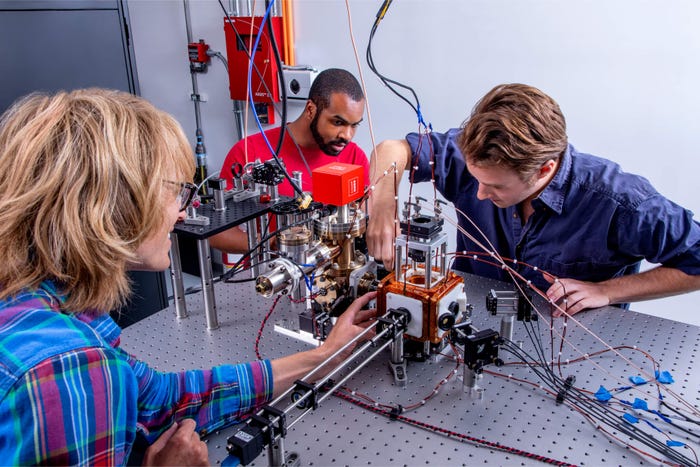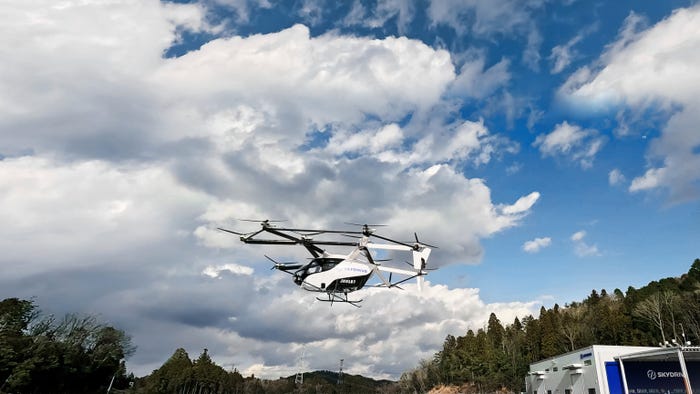Flying Taxi Company Expands in China; Sets Vehicle Price at $410KFlying Taxi Company Expands in China; Sets Vehicle Price at $410K
A joint agreement aims to provide support to EHang for technology research and promotion for vehicle uses
February 13, 2024

A Chinese eVTOL (electric vertical takeoff and landing) vehicle maker has formed a strategic partnership to grow its flying vehicle business in China.
EHang Holdings formed a strategic partnership with the Guangzhou Development District Administrative Committee and the Guangzhou Automobile Group to team for research and development, production and sales to expand in the advanced air mobility (AAM) industry.
EHang also set $410,000 as the suggested retail price of its EH216-S electric aerial vehicle in markets outside of China.
The EHang passenger-carrying unmanned aerial vehicle (UAV) is approved for flying passengers.
The new joint agreement is aimed at providing support to EHang for technology research and development, production and promotion for vehicle uses in Guangzhou.
"As a local enterprise in Guangzhou, we are delighted to harness EHang's leading advantages in passenger-carrying UAVs to partner with the Management Committee of Guangzhou Airport Economic Zone, the Administrative Committee of Guangzhou Economic and Technological Development District and GAC Group for propelling the high-quality development of Guangzhou's low-altitude economy,” said Huazhi Hu, founder, chairman and CEO of EHang.“
EHang previously partnered with the Bureau of Culture, Radio, Television, Tourism and Sports of Luohu District, Shenzhen municipality, to grow its electric aerial vehicle (EAV) business in the cultural, commercial and tourism sectors.
As part of that agreement, the construction of multiple urban air mobility (UAM) operation centers to serve as hubs for both aerial sightseeing and public transportation are expected to be created.
The EH216-S EAV from EHang previously received a standard airworthiness certificate (AC) from the Civil Aviation Administration of China (CAAC), the first of its kind globally for an EAV.
The long-range goal of the flying vehicles industry is to have EAVs evolve from piloted vehicles, such as the coming air taxis, to aerial vehicles that fly automatically, with no crew onboard.
While some EAV makers such as Wisk in the U.S. are planning to start this way in the future, it is not in the most recent Federal Aviation Administration (FAA) electric aerial vehicle planning documents.
EHang has been active in marketing its self-flying vehicles globally.
For example, the company recently delivered an EAV to Eton, an aviation technology subsidiary of Guangzhou Development District Communications Investment Group, which is managed by the government of Huangpu District in Guangzhou.
The plan is to use the EAV for aerial tourism in Guangzhou.
EHang also extended its operations to the United Arab Emirates (UAE) including the sale of up to 100 of its flying vehicles.
EHang joined the Smart and Autonomous Vehicle Industries Cluster in Abu Dhabi and formed a partnership with Wings Logistics Hub, a passenger eVTOL subsidiary of Technology Holding Company.
The two companies plan to develop urban air transportation and smart city management in the UAE, Middle East and North Africa regions.
The cluster, led by the Abu Dhabi Department of Economic Development and the Abu Dhabi Investment Office, aims to establish Abu Dhabi as a hub for smart and autonomous vehicles.
As part of this new agreement, Ehang plans to work with Wings Logistics to obtain local certification of its EAV in the UAE.
Wings Logistics Hub intends to buy up to 100 of the flying vehicles from EHang with the first deliveries starting this year.
Ehang recently opened a UAM center at the Lleida–Alguaire International Airport (LEDA) in Catalonia, Spain, to manage its EAVs there.
The UAM center includes a vertiport, which incorporates with the airport terminal, platform, control tower and airport regulations, aims to enable the vertical takeoff and landings of EAVs.
During the EAV validation process, which included more than 40,000 test flights, the vehicle underwent laboratory, ground and flight tests at test sites across multiple locations in China, according to the company.
The tests included “structural strength, flame resistance, crashworthiness, gas toxicity, environmental conditions of equipment and systems, software simulation, data links, ground control stations, overall system functionality, electromagnetic compatibility, flight performance and flight stability characteristics,” according to the company.
Like what you've read? For more stories like this on flying cars and emerging technologies, sign up for our free daily email newsletter to stay updated!
You May Also Like






